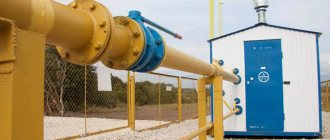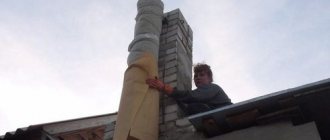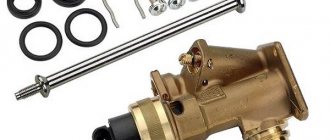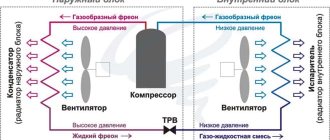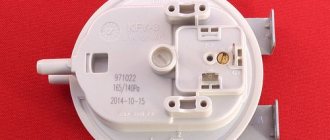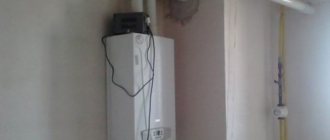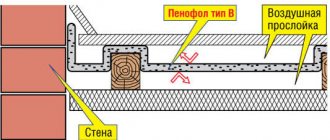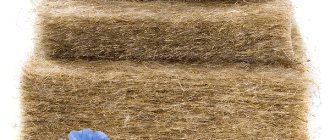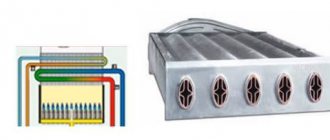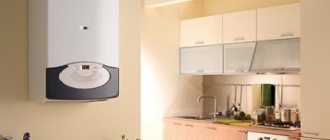The operation of gas heating equipment, such as a boiler or gas water heater, is always associated with the release of toxic substances into the atmosphere. Carbon monoxide is a toxic substance that is colorless and odorless. Therefore, you may not notice the poisoning. Inhalation of even small amounts of gas requires medical attention. The best option would be corrugation for a geyser.
Purpose
To eliminate it, you need a smoke exhaust pipe that will remove carbon monoxide to the street and will not cause harm to household inhabitants. For a gas water heater, you can install a chimney yourself.
Varieties of corrugation
In the production of corrugated pipes, two main materials are used:
- Aluminum;
- Steel.
Aluminum, or rather its alloys, are used for equipment with temperatures up to 500 degrees. As the temperature rises, the walls begin to burn out. Therefore, such materials cannot be used with solid fuel boilers and fireplaces. But in the case of geysers, they are perfect.
It is not subject to corrosion, so it can be installed even in conditions of high humidity. The only weakness of aluminum is acidic and alkaline environments.
Stainless steel is not temperature sensitive and can be used in high temperature environments. Alloy steel is not afraid of high humidity.
Advantages and disadvantages of corrugation
The advantages of corrugation include:
- The spiral shape of the corrugated pipe is the most convenient for gas venting. Since carbon monoxide is much lighter than oxygen, it rises. Unlike smooth-walled tubes, it goes in a spiral and leads out. Square pipes are prone to condensation forming in the corners, which over time corrodes the profile.
- The round cross-section is convenient to install. There is no need to use adapters or additional adapters.
- In case of damage, it is possible to quickly change the pipe. Minimum tools and time saving.
- No corners or other fittings are needed. The corrugation bends easily and allows you to turn it in any direction.
- Flexibility allows you to lay the pipeline the way you want it.
Flaws:
- Insulation required. Mobility requires thin walls, so they cool quickly when the temperature drops. Mandatory insulation with mineral wool or asbestos is required.
- High susceptibility to shock. Direct mechanical impact will lead to guaranteed damage to the tube.
The corrugation for a stainless steel geyser can be used in a private house and apartment.
FLEXIBLE STAINLESS STEEL CHIMNEYS
Stainless steel corrugation for a chimney is the most acceptable option when connecting to equipment with high flue gas temperatures: wood stoves, fireplaces, pellet boilers. Without loss of sealing, stainless steel corrugation can withstand heating up to 900°C.
A corrugated stainless steel chimney has the following advantages:
- Steel thickness is from 0.12 to 1 mm.
- Ability to compress and stretch.
- Flexibility.
- Resistant to high temperatures and acidic environments.
The corrugation for a stainless steel chimney has one undeniable advantage, which is the ability to install the chimney without the use of adapters, corners, adapters and other fittings. The pipe bends in the desired direction without loss of integrity.
___________________________________Hi all!__________________________________
There are many articles and questions on the Internet about whether gas workers’ demand to replace “soft” corrugation with metal is legitimate. Gorgaz in my city has also not lagged behind the general mass in Russia, and for several years now they have been gently reminding me to replace the corrugation on the gas water heater. At the same time, they scared me with some kind of “prescription” that would be written out in my name, but they didn’t write it out..
READ MORE: Textured paint for walls: types and techniques for applying relief composition
Selecting a chimney
Pipe material
The service life and strength depend on the material. Therefore, it is worth relying on this indicator. The use of materials is regulated by building codes and regulations - GOST.
Corrugation
It is better to use corrugation after consultation with an inspector. At the legislative level, corrugated chimney pipes are not prohibited. But sometimes the inspection may require replacing it with galvanized or steel.
The main ones used for chimneys are:
- Stainless steel. Option for apartments and private houses. Stainless steel is neutral. Does not interact with moisture, acids and alkalis. Feels comfortable at temperatures up to 900 degrees Celsius. The gas outlet is flexible and can be installed in any direction. The wall thickness is up to 1 millimeter and it is better to take stainless steel.
- Aluminum. Formally, aluminum and its alloys can be used for geysers, since its operating temperature is up to 500 degrees Celsius. But, it can burn out, which will cause carbon monoxide to return to the apartment. In this case, the slightest etching will cause deterioration in health.
- Galvanization. Operating temperature – up to 600 degrees. This already allows them to be used with low and high temperature speakers. Zinc coating is highly sensitive to damage and acids. In case of minor damage, corrosion will be irreversible.
Consultation with an expert is advisable, because in a number of regions of the Russian Federation, only galvanized and steel straight pipes are allowed to be connected. Corrugation may be prohibited due to climatic conditions. Read the instructions for the column. It specifies acceptable materials and types of chimneys. If corrugated gas outlets are prohibited, it is better not to risk it.
Coaxial ducts
A gas water heater with a coaxial chimney is permitted by SNiP requirements. They are necessary in water heaters with active oxygen supply
A coaxial pipe is a two-section cavity. The internal part is designed to remove combustion waste that is harmful to health. From the outside there is an active intake of air for combustion.
There are varieties:
- Plastic. The material is convenient because it weighs little and is easy to install. Has convenient mounting locations. Used only in low-temperature speakers, as the plastic is short-lived and can melt. Does not suffer mechanical damage, but is resistant to alkaline and acidic environments. Moisture doesn't harm it at all.
- Stainless steel. Steel is resistant to temperatures, acids, humidity and mechanical stress. There are insulated and non-insulated models. If you live in a cold region, you need the first one. During cooling and heating, the uninsulated pipe makes a loud clicking sound. In addition, she may be led. Has several types of connection:
- Vertical. Relevant in apartment buildings where it is not possible to install a horizontal installation.
- Horizontal. The classic method for multi-storey and private houses.
Stainless steel
If the rules prohibit corrugation for hood 120, it is possible to use a solid stainless gas vent. Neutral to condensate with soot and water. It is not afraid of impacts and is easy to clean. The properties are maintained up to a temperature of 900 degrees, so it can be used for high-temperature columns.
Chimney for a geyser - corrugated and steel air ducts
Such questions from residents are often received by the portal’s editors. Especially for Myslo readers, we asked Tulagorgaz to clarify all the nuances of replacing chimneys from gas instantaneous water heaters.
A geyser is a device that can provide uninterrupted hot water supply in an apartment. A gas water heater is safe to use if you strictly follow gas safety rules.
One of the important conditions for the safe operation of a gas appliance is to ensure the removal of combustion products generated during operation of the column using a smoke exhaust.
According to technical regulations, aluminum corrugated chimneys are not prohibited. However, at the same time, the regulations state that stainless steel is the most preferred material for the manufacture of chimneys; connecting and chimney pipes must be made of non-combustible materials, be dense and prevent air leaks at the connections and in the places adjacent to the smoke duct.
The use of aluminum chimneys requires the user to constantly monitor the integrity of the corrugation and its reliable connection to the chimney.
JSC Tulagorgaz, as a specialized organization with more than 60 years of experience, recommends using steel (galvanized) chimneys when installing or replacing a gas water heater. The use of steel chimneys is a safe way to operate gas equipment.
In apartment buildings, the management company should check the condition and functioning of smoke and ventilation ducts, repair them and, if necessary, clean them. In practice, the management company enters into an agreement with an organization that is authorized to carry out such work and has the appropriate license.
Smoke and ventilation ducts must be checked at least 3 times a year (no later than 7 calendar days before the start of the heating season, in the middle of the heating season and no later than 7 days after the end of the heating season).
In addition, subscribers are prohibited from using gas equipment in the following cases:
- Lack of a maintenance agreement;
- Lack of draft in chimneys and ventilation ducts;
- Lack of air flow in the amount necessary for complete combustion of gas, including for the following reasons: the absence or presence in the closed position of an adjustable window sash, transom, window leaf, special air supply device in external walls or windows, the closed position of the louvre grille on the ventilation duct in a room in which household gas-using equipment is installed;
- Use in a room in which household gas-using equipment with exhaust of combustion products into the smoke duct is installed, devices for electro-mechanical stimulation of air removal, not provided for in the design documentation;
- Lack of timely inspection of the condition of smoke and ventilation ducts;
- Lack of a sealed connection between the chimney of waste gas-using equipment and the smoke duct;
- The presence of a violation of the integrity and density of the brickwork (presence of cracks, destruction), the tightness of smoke and ventilation ducts;
- There is a malfunction of the safety automatics;
- Presence of a gas leak that cannot be repaired during maintenance;
- The presence of a malfunction, understaffing or unsuitability for repair of gas equipment;
- Presence of unauthorized connection of gas equipment to the gas pipeline of the gas distribution network or other source of gas.
Maintenance of gas equipment is carried out once a year. Conducting it in a timely manner is the key to your safety!
You can call a specialist by phone: 25-36-68, 25-36-56, 25-36-37. Or leave a request on the website.
JSC Tulagorgaz has a flexible work schedule; maintenance of gas appliances is carried out on weekdays in the evening, as well as on Saturdays.
- JSC Tulagorgaz does not connect gas equipment with the removal of combustion products to chimneys made of corrugated aluminum.
- Tulagorgaz carries out installation/replacement of gas instantaneous water heaters. After installation of the chimney by a specialized organization, specialists from Tulagorgaz JSC will connect the equipment, provided that the chimney is securely and tightly connected to the chimney.
- Tulagorgaz does not connect gas equipment until a specialized organization eliminates the violations and provides a certificate of serviceability of chimneys and ventilation ducts if there is no steel restrictive ring in the chimney and if the diameter of the chimney does not correspond to the data specified in the manufacturer’s passport.
For questions regarding the manufacture and installation of steel chimneys, residents can independently contact specialized organizations in Tula and the region.
At JSC Tulagorgaz you can make a request to call a measurer and subsequent manufacture of a steel chimney by calling 25-36-57.
No. 1. The cross-section of the chimney does not meet the requirements of the manufacturer and the passport for gas equipment.
No. 2. Loose connection of the chimney from the gas water heater to the chimney.
No. 3. The most preferred material for making a chimney is stainless steel. The connection of the smoke exhaust elements must be in the direction of movement of the flue gases.
No. 4. There is no vertical section and the horizontal section of the smoke exhaust from the gas water heater is not maintained; the corrugation itself is severely deformed and unsafe to use. During operation of a gas appliance, carbon monoxide may escape into the room.
Violation No. 5. There is no access to check the connection between the chimney and the chimney.
One of the most common devices that can provide uninterrupted hot water supply to a home is a gas water heater. It does an excellent job of heating any volume of water in the shortest possible time. At the same time, modern modifications allow you to clearly set the required temperature and automatically turn on and off in accordance with the operating mode of the water point.
Gas-powered instantaneous water heaters are quite economical and safe to use. The only inconvenience is the need to organize high-quality removal of combustion products. This problem can be solved once and for all only with the help of proper installation of an exhaust pipe for a geyser.
According to the table of definitions NPB 252-98, the exhaust pipe for a gas water heater is the connecting pipe for the smoke exhaust pipe of the device and the smoke duct. Accordingly, it transports gas combustion products and must meet the requirements for chimneys. Failure to comply with them can lead to gas pollution in the room and carbon monoxide poisoning.
All requirements for chimneys are set out in the following regulatory documents:
- NPB 252–98;
- Rules for the production of pipe and furnace works VDPO;
- SP 42-101-2003, Appendix G
- SP 60.13330.2012, which is an updated version of SNiP 41-01-2003 (replacing SNiP 2.04.05–91).
The main provisions that directly relate to smoke removal from household gas water heaters boil down to the following points:
- The cross-sectional area of the exhaust pipe is taken to be no less than the cross-section of the outlet pipe of the unit;
- It is necessary to ensure complete tightness of the chimney, its resistance to corrosion and high temperatures up to 200 °C;
- Laying connecting pipes through living rooms is prohibited;
- The vertical section of the exhaust pipe at the outlet of the column must be 500 mm high, in some cases it can be reduced to 250 mm;
- Connecting pipes should be up to 3 m long in new buildings and up to 6 m in existing ones;
- It is allowed to use no more than 3 turns with a bend radius no less than the diameter;
- The exhaust pipe is installed at a distance from the ceiling or wall made of non-combustible materials of at least 5 cm, if they are combustible or difficult to burn, then at least 25 cm. The distance can be reduced to 10 cm by taking protective measures in accordance with SP 42-101-2003;
- If the connecting pipe for a gas water heater passes through an unheated room, then thermal insulation must be used;
- The exhaust pipe must be laid with a slope of 0.01 or more towards the appliance.
Smoke ducts are installed in walls made of non-combustible materials and are insulated, if necessary, to prevent condensation. If there are no suitable walls or the building in use does not have channels for removing combustion products, then install a top-type or root-type chimney.
Each fuel-burning device must have a separate smoke duct or pipe. In some cases, it is allowed to remove exhaust gases from the column and boiler into one chimney with an increase in the cross-section of the pipe. In this case, the combustion products must be introduced into the channel at different levels at a distance of at least 0.75 m or at the same level using a cut with a height of 0.75 m and a thickness of 0.12 m.
READ MORE: Is it possible to run an electrical cable under a concrete path?
The chimney must be strictly vertical and have at the base a removable pipe or pocket 250 mm deep with a door for cleaning soot. If it is necessary to bypass existing obstacles, a deviation of up to 30° from the vertical is allowed, while the cross-sectional area is maintained, and the offset should not exceed 1 m.
Installation work
Assembly occurs in the following order:
- Choose a location where the pipe will go straight up. There should be no obstacles along the way that have to be avoided. Any bevels will interfere with outflow.
- An elbow is installed at the outlet of the column. Installation of flexible corrugation made of steel is possible. Insulation is not needed in this place, since condensation does not form due to the high temperature.
- Now we install the chimney. It is mounted on a bracket and clamp.
- The outer part should be insulated if it is bare. This way you will get rid of excess condensation and protect the pipe from contact with moisture and the environment.
- A fuse is installed on top to protect the drain from moisture.
- A condensate collector is installed.
Installing a geyser hood is the same in both an apartment and a private house. The difference is in the installation of the chimney. In apartment buildings, a vertical chimney is made with an additional bend and a passage through the wall.
Installation Aspects
Geysers and boilers always produce toxins that can enter the room. To avoid this, listen to the advice of installers on selection and installation.
Types of gas outlet pipes
Gas outlets are often made of metals. A noticeable disadvantage of this is the guaranteed formation of condensation. The reason is the temperature difference between the gases inside and the cold air outside. To avoid this, you can buy and install fire-resistant thermal insulation. Some requirements already come with insulation inside.
The problem is also solved using a coaxial gas outlet. Two separate compartments for carbon monoxide removal and oxygen intake will prevent water droplets from forming.
Corrugated pipes can be used. Since waste moves quickly inside, it does not have time to cool before exiting.
Dimensions of chimney pipes
Dimensions (diameter, wall thickness, length) are calculated based on the power of the equipment and the environment. In most regions of the CIS, the use of pipes 11 centimeters in diameter is acceptable.
The instructions for the heating device indicate the recommended dimensions.
Installation standards
The gas outlet in contact with the wall must be insulated with fire-resistant material. It is advisable to use mineral wool.
Sometimes two devices can be connected to one pipe:
- If two boilers are installed on one floor;
- Two speakers installed.
When installing, observe the following rules:
- Mounting elements must not burn;
- Butt sealing is carried out using non-flammable mixtures;
- You cannot use more than three knees;
- The pipes must not be damaged.
To prevent condensation indoors, it is better to insulate the walls in the room.
Features of boilers and columns
Systems with a closed combustion chamber must be equipped with a coaxial flue exhaust. It will be able to create active oxygen saturation and removal of combustion products. Boilers and dispensers with forced air supply require the installation of a blower fan. The ventilation system turns on simultaneously with the heating. Proper installation will reduce the likelihood of toxins entering the apartment.
Compatibility of the chimney with the hood
The simultaneous use of a gas outlet and an exhaust hood is not allowed. A running exhaust system can knock out the fire, which can lead to gas poisoning.
Even if attenuation does not occur, there is a possibility of carbon monoxide entering the room. When using gas equipment, this is unacceptable.
Chimney draft
An indicator expressing the efficiency of combustion products exiting through a pipe. Determined by the rate of removal of toxins from the chimney system.
The higher the indicator, the better the removal of carbon monoxide and the penetration of oxygen to the burner.
Dangerous consequences of malfunctions
The exhaust pipe for the geyser may become clogged. Because of this, carbon monoxide can penetrate into the room, creating a danger to human life. Carbon monoxide is odorless and tasteless, so its penetration may not be noticed. This is especially dangerous at night. The sooner a leak is detected, the better. In case of mild poisoning, unpleasant symptoms appear: migraine, nausea, dizziness, vomiting. If it's strong, it means death.
Blockage is also dangerous because oxygen stops getting into the system. This causes the wick to fade. Combustible substances enter the atmosphere, poisoning the air. However, it can be detected by smell.
CORRUGATED CHIMNEYS FOR GAS HEATERS
The rules for installing gas consuming devices are given in the standards for the placement of gas distribution systems SP 42-101-2003, according to which the basic requirements for the supply pipeline and the installed column are formulated as follows:
- To lay the internal gas pipeline, only steel or copper pipes are used; the use of stainless steel bellows hoses is recommended as a flexible connection.
- The service life of the flexible liner must comply with standards and not fall below 12 years, its outer shell must be yellow to indicate use in gas pipelines, and the internal cross-section cannot fall below 10 mm.
- In flexible lines for supplying fuel to household appliances, butt connections are not allowed.
- If gas-consuming units are connected to electrified household appliances, special insulators are used on the gas pipeline to prevent the passage of equalizing and leakage currents after they are shorted to the body of the units.
- Fastening the gas pipeline is permissible on non-combustible supports, and the location itself must provide for convenient accessibility for viewing and repairing the pipeline and consumers connected to it.
- It is unacceptable for the flexible gas supply line to cross openings of windows and doors, ventilation grilles, or to install it hidden.
- When pulling a pipeline through the structural elements of buildings, it is enclosed in a sleeve from a section of steel pipe with the internal space filled with tow, rubber bushings and other sealing building materials.
- For rooms with installed gas-consuming appliances (dispenser, boiler), the accepted standard for ceiling height is 2.5 m; if its power does not exceed 60 kW, a distance from floor to ceiling of 2 m is allowed.
- Natural ventilation is calculated as follows: the hood must pump 3 times the volume of air per hour, the inflow must correspond to the exhaust with the addition of air masses for gas combustion.
- The parameters of the exhaust and supply systems are calculated for units up to 60 kW.
- The room is equipped with glazing with parameters of 0.03 m2 per 1 m3 when installing a unit with a power of more than 60 kW or its location in the basement.
- When installing units with a power of 150 kW or more in basement and basement rooms, it is necessary to place a separate exit if the house is blocked or has one apartment.
- It is allowed to convert factory dispensers running on solid and liquid fuels (turbocharged units) to gaseous power supply, if they are designed to provide such a possibility. Rice. 3 Rules for connecting to the chimney
- The distance from the structural elements of buildings to gas consuming units must comply with the standards from their operating manual; if there is no data, for suspended water heating units the following gap is accepted:
- between fireproof front and side walls and the body of the device - from 2 cm.
- between thermally insulated front and side walls made of slow-burning and combustible materials - at least 3 cm.
- If the walls are made of flammable and fire-resistant building materials, the gap from the water heating unit to their surface without insulation is made at least 25 cm.
- Wall insulation must exceed the overall dimensions of the device by 10 cm at the bottom and sides and 70 cm at the top.
- The horizontal distance from the protruding elements of the column to the hob surface of the stoves is taken from 10 cm, in the passage - not less than 1 m.
READ MORE: Ceiling-mounted, wall-mounted clothes dryer for a balcony; types of photos;
Typical operating instructions provide for the following requirements for the placement of gas-using equipment:
- The unit is installed in kitchens or non-residential rooms in accordance with SNiP 42-01-2002 standards (updated version of the above standards - SP 62.13330.2011), fire safety rules PPB 01-03.
- Installation of a geyser is permitted in rooms with a total volume of at least 8 m3. This provision clearly shows that the column cannot be hung in a standard bathroom of a standard apartment, having dimensions of 1.5x1.5x2.5 m, that is, with a volume of 5.625 m3, which is lower than the normalized figure.
- A room with a water heater is ventilated with a continuous flow of air (an open window, a transom in a window); the cracks or grilles at the bottom of the door leaf cannot overlap. Rice. 4 Traction check
- The unit is connected and installed closer to the chimney duct with good draft (resolution 1.96 - 29.4 Pa), a simple way to evaluate its effectiveness is shown in Fig. 4.
- The walls on which the water heater is installed are made of fireproof materials (brick, concrete, ceramic cladding).
- The location of the unit relative to the walls must comply with the standards of SP 42-101-2003.
- The device must not be placed on walls made of wood, covered with plaster or other building materials, or on flammable surfaces; installation above sources of thermal radiation or open fire is not allowed.
- For ease of use, the device is suspended at a height at which the viewing window is placed at eye level, the distance to the side wall is taken to be more than 150 mm, in front of the front wall of the unit - not less than 600 mm.
- The water pressure in the system cannot fall below 0.1 atmosphere (bar).
- A cleaning filter and a shut-off valve are installed on the water supply pipeline in front of the unit, located in an easily accessible place.
- The permissible diameter from the inside of a flexible line or metal pipes for supplying cold water to the unit is from 13 mm, the length of the flexible hose is up to 2.5 m.
- The gas supply hose must withstand the pressure in the system and the extreme temperatures at the location where it is placed, its length is up to 2.5 m, and the number of connections during installation is kept to a minimum.
- The gas supply should be shut off with a shut-off valve; it should be located as close to the installation as possible.
- When connecting to a chimney, the material used to make the flue is chosen to be resistant to hot air and the chemical composition of gas combustion products: it must be corrosion-resistant, non-flammable, and withstand long-term operation at 200 °C. Suitable materials for making a chimney are stainless steel, aluminum, copper with walls from 0.5 mm.
- The diameter of the gas exhaust pipe is taken to be no less than 110 mm, the height of the vertical section is no less than 500 mm.
- The length of the outlet pipe to the vertical section of the chimney (hood) is no more than 2 m.
- The slope to the junction with the chimney (hood) is taken from 2 degrees, the number of turns is minimized and does not exceed the threshold of 3 bends.
Rice. 5 Flexible connection options
The aluminum corrugation for the chimney has a design identical to that used in the analogue made of stainless steel. At the same time, aluminum is significantly inferior to the latter in strength and heat resistance.
According to SP 42-101-2003, aluminum corrugated chimneys for gas boilers are not prohibited. But as practice shows, in most cases, inspectors require that the chimney be made from a different material. This is explained by the fact that the aluminum corrugation in
as a chimney, it is not able to withstand temperatures above 500°C and often, after the soot ignites, the walls burn out, which leads to combustion products entering the living space. Recently, such cases have become more frequent. Therefore, the restrictions are completely justified.
It is possible to use aluminum corrugation for the chimney from the boiler, but it is not recommended. To avoid problems with registration and commissioning of gas equipment, it is best to opt for a stainless pipe. For connection to heating equipment, you can only use certified corrugation that has an operating permit issued by Rostechnadzor.
It is possible to use flexible metal chimney corrugation for a gas boiler, as well as any other heating equipment, due to the high technical characteristics of the material. There are several important aspects to consider:
- Aluminum pipes can burn out after several years of use. Therefore, if there is a need to connect a corrugated chimney, it is better to choose a sleeve made of stainless steel.
- The material has poor heat-saving characteristics. To reduce the production of condensate, you will need to add heat and sound insulation to the corrugated pipe. To do this, you can use non-flammable mineral insulation 5 cm thick. Thermal insulation is wound around the pipe and covered with any foil reflector on top. Fixed with a knitting wire.
- To connect pipe sections of different diameters, special adapters are used.
Installing a corrugated chimney in the kitchen, where a gas water heater is usually installed, is a completely justified solution. Despite the fact that the temperature inside the boiler rises to 1000-1200°C, at the outlet it drops sharply to 200-300°C. Even an aluminum pipe will retain its strength and tightness at such temperatures.
What should you think about before using corrugation to connect the column to the chimney?
- Diameter - the technical documents for the column must indicate the dimensions and cross-section of the pipe connected to the outlet pipe. It is strictly forbidden to use an aluminum pipe with a smaller cross-section. This leads to increased heating of the structure and, as a rule, deformation of the walls, burnout, and loss of tightness.
- Parameters - the permissible maximum length of the chimney corrugation when installing a gas water heater is 3 m. Quality certificates must specify operating parameters, including the possible surface heating temperature. If the temperature of the exhaust gases is 200-300°C, then a corrugated pipe with an operating mode of 350°C can be used to install a chimney for a gas water heater.
Installing flexible fireproof corrugated stainless steel pipes for geyser chimneys would be the best option. The temperature of the column exhaust gases is within 300°C; if necessary, aluminum analogues can be used.
To calculate the cost of corrugation, you will need to take into account several important points:
- The total length of the chimney. The standard package includes an aluminum pipe capable of stretching from 0.65-3 lm. Stainless steel corrugation stretches slightly, so when making calculations it is necessary to take the length indicated on the package. You can buy one aluminum sleeve for 350-380 rubles. A stainless steel pipe will cost 650-700 rubles. for 1 p.m.
- Pipe diameter – stainless steel hoses are manufactured with a cross-section from 80 to 500 mm. Aluminum ones have a diameter of 110 and 130 mm. When choosing, you must take into account the parameters of the heating equipment and strictly follow the manufacturer’s recommendations. If a material is selected for the rehabilitation of a chimney made of corrugated aluminum, which will be used in wood-burning stoves, then the diameter of the pipe should be smaller than the internal channel of the brickwork.
- Fittings - you will need to buy adapters, adapters and flanges.
Ways to check traction
How to check the draft in a gas water heater? There are two ways to identify a blockage and remove it in time.
It is worth checking them before starting heating to avoid poisoning. Often in summer, plugs form in pipes. The cause is insects and birds that like to build nests in cool pipes.
Anemometer
The exhaust pipe for a gas water heater can be checked with an anemometer. He checks the speed of gas movement. It is enough to place the sensor with a fan at the chimney outlet and see the result on the screen. Compare with normal values and determine the difference.
The disadvantage of an anemometer is its high price. Cheap Chinese models will not give a complete picture, as they work with large errors. But they are suitable for everyday use.
Folk method
Take a lighter and bring it to the lowest point of the pipe while the boiler is running. In the absence of interference, the flame should be “swallowed” inside. If this does not happen, carry out cleaning work.
